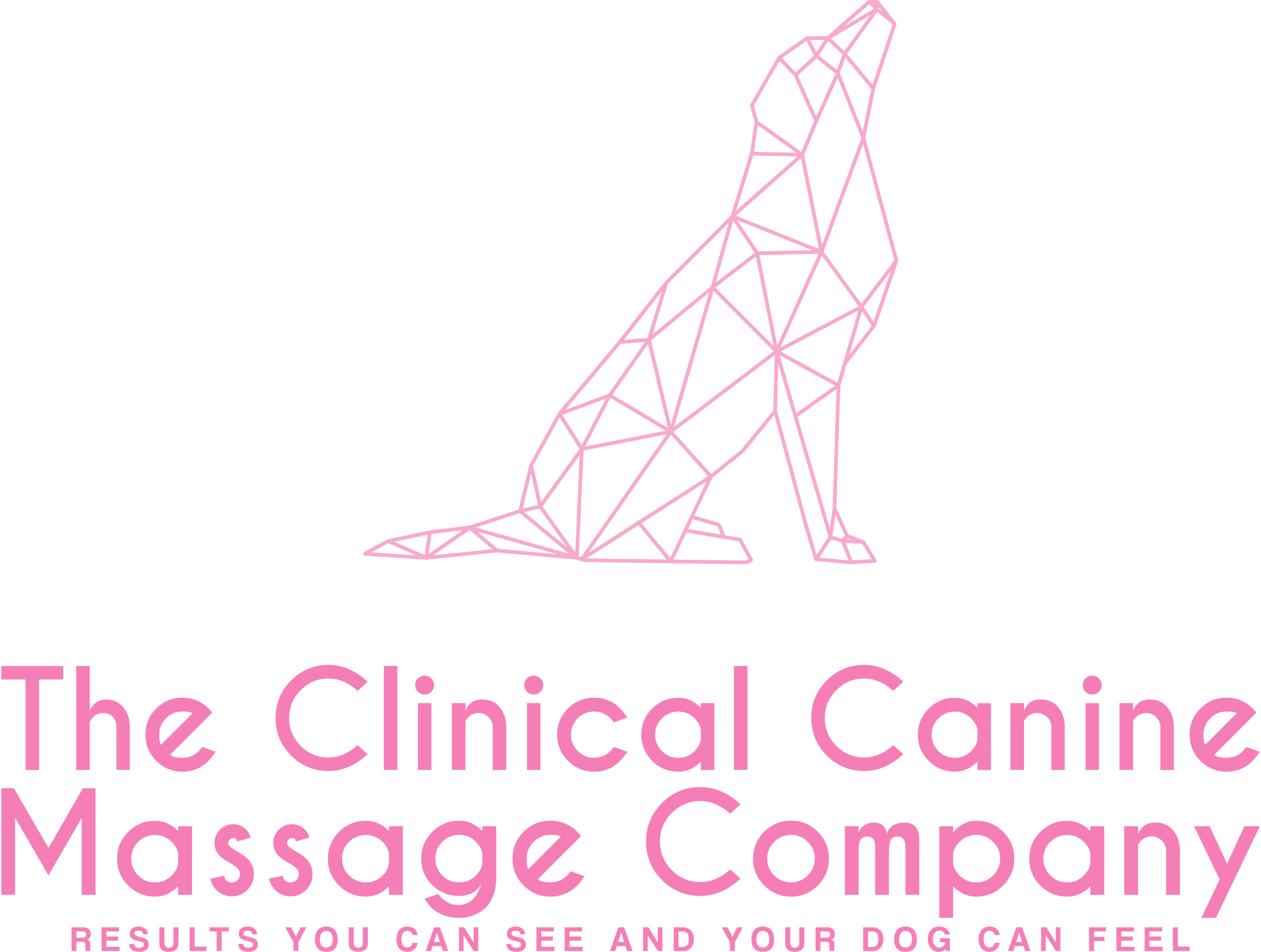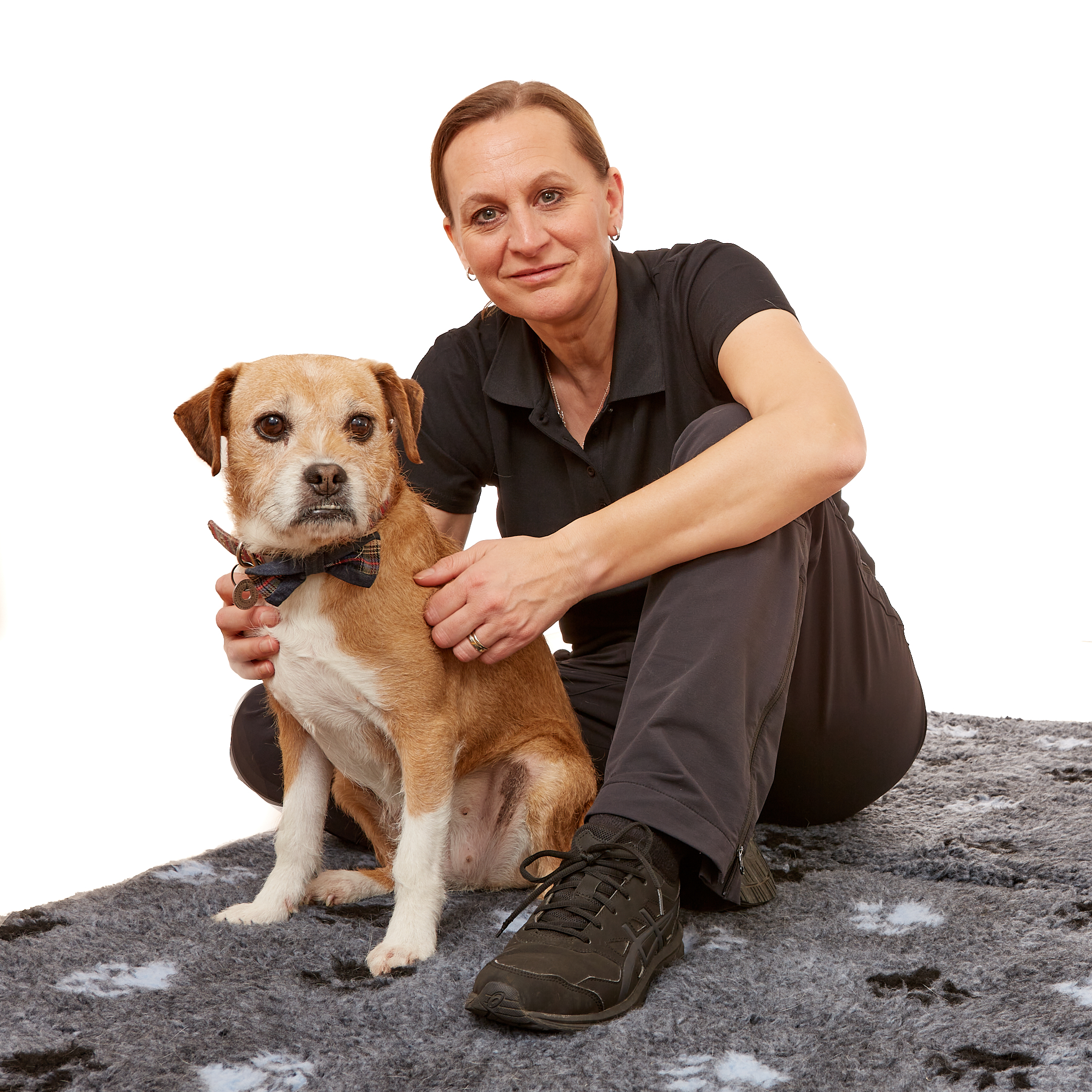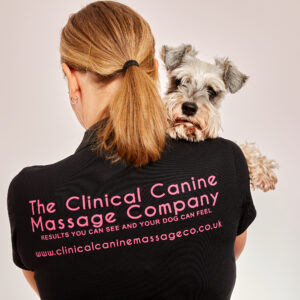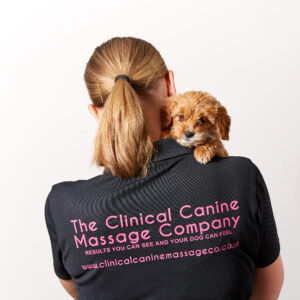Meet Minnie, a Border Terrier/Pug cross breed who came to me for a massage to address her anxiety issues. Minnie used to belong to an elderly lady who had showered her with love and a few too many treats. Sadly, Minnie’s owner had passed away a couple of years ago and Minnie had to be rehomed. Her new environment only exacerbated her anxiety, and Minnie spent the first few months cowering under the table, too afraid to come out and meet her new family. Her new owners Tim and Ginny and their two dogs Tink and Minty gave Minnie the space that she needed to adjust, and eventually with patience and kindness, Minnie felt confident enough to come out of her hiding place and began to settle into her new home. Minnie was put on a healthy diet and lost her excess weight and was able to enjoy long walks with her new family, but despite the progress being made, she remained very nervous, especially when meeting new dogs or people. Minnie was particularly sensitive to noise.
Minnie’s owner Ginny had heard about Clinical Canine Massage through a friend. Hoping that it might help to ease Minnie’s anxiety, she put Minnie forward to be used as one of my case studies. I was excited about working with Minnie and I really wanted her to be able to relax and enjoy her massage. I met Minnie and Ginny outside my house. Meeting a dog for the first time is always better done in neutral space especially if you have dogs of your own. This was especially important in Minnie’s case as I didn’t want to cause her any unnecessary anxiety. It is also an ideal opportunity to conduct a gait analysis and I watched Minnie as she moved up and down the road. When she walked, she looked slightly stiff in her hindlegs, but other than this she appeared to have no apparent gait issues. As she came into the house, she virtually clung to Ginny’s legs. Her posture indicated that she was nervous. Her back was roached, her tail hung limply between her legs and her eyes flickered nervously as she surveyed the unfamiliar surroundings.
I spoke to Minnie in soft gentle tones. I tried not to crowd her and gave her the time and space that she needed to explore the room. Meanwhile I sat down with Ginny to go through the initial consultation. I gained all the information I could regarding Minnie’s background, daily routine, and habits to help me to build a picture to enable me to tailor her treatment. Ginny had brought a coffee cup with her to drink which had a flip lid. Every time she flipped the lid open, Minnie jumped out of her skin. Realising that this was causing Minnie anxiety she stopped drinking it and put it to one side. I had downloaded some soothing classical music which I hoped would settle Minnie and I had it playing softly in the background.
Although she was sceptical, Minnie allowed me to complete a full body muscular health check. I noted that she was sore at the bottom of her back and her range of movement in all four limbs was restricted. I began the massage, but Minnie found it difficult to settle. She was very uncertain of me and jumped at every sound. She didn’t feel comfortable enough to lie down, so I gently massaged her as best as I could in a seated position. As I touched her, she edged away from me towards Ginny and looked at me suspiciously out of the corner of her eyes. I persevered, taking care not to crowd her. It was plainly obvious that Minnie couldn’t be rushed into trusting me. I needed to be kind and patient with her. At the end of a tentative massage, I gave Ginny some massage aftercare advice and we arranged a suitable time for her next session the following week.
During the week that followed, I spent some time downloading some Solfeggio Frequency 432HZ music to play during Minnie’s second massage. This music is played at a specific frequency and is known as the ‘healing frequency’. It is known to reduce stress and anxiety. It works particularly well with dogs and can really help to complement a relaxing massage. When Minnie arrived for her second session, I had my room all set out with the dulcet Solfeggio Frequency music playing softly in the background.
Minnie walked into the room and already I could see that she looked like a different dog. Her body language had changed. Her back was no longer roached, and she held her tail high with a newfound confidence. She no longer clung to her owner Ginny, and she bounded across the room enthusiastically to greet me. Following her muscular health check, I started the massage. She was happy to lie down on her side this time and stayed there for the entire 50-minute massage. When I turned her over to massage her on the other side, she promptly lay back down and fell fast asleep. Minnie had really seemed to enjoy her massage and I didn’t want to stop. I’m sure she would have been happy to let me massage her all day. I was really pleased for her.
Ginny had told me that Minnie had been tired following her first massage. I had given her some aftercare advice the previous week which had included information about the Healing Crisis, which is a worsening of symptoms as the body manoeuvres through the healing process and returns the body to a state of homeostasis. It is a natural process, which should be embraced as a positive experience. The symptoms of the healing crisis, which can include fatigue, are transient and usually clear within a few days.
For Minnie’s final massage, I went to her house. When she saw me, she bounded across the room to greet me, wagging her tail as though I were a long-lost friend. Ginny had ensured that her other two dogs, Tink and Minty, were locked away in another room so they wouldn’t disturb the massage. I had brought my portable speaker with me so that I could play the Solfeggio Frequency music in the background. Minnie immediately lay down beside me and waited in anticipation for her massage. Before I started, I completed her muscular health check and was pleased to see that the pain in her lower back had eased from the previous week. I began the massage and she lay still for the entire 50 minutes.
Over the three sessions, I had witnessed an unquestionable improvement to Minnie’s anxiety levels as well as an improvement in her overall range of movement and pain levels. Minnie was happier and Ginny decided to book her in for regular monthly maintenance massages.
Clinical Canine Massage is a non-invasive manipulative therapy which can help to rehabilitate soft tissue injuries such as sprains and strains, manage pain from chronic orthopaedic issues such as arthritis and hip dysplasia and help to reduce stress and anxiety levels. It can also help improve posture, such as roaching, gait, such as lameness or limping, sporting performance, mobility and can speed up the process of recovery following injury or surgery.
I use 4 massage disciplines including Swedish, sports, myofascial release, deep tissue and the Lenton method, a specific set of myofascial release techniques which has been clinically trialled at Winchester University. All treatment is authorised by a veterinary surgeon and visible results are usually achieved in 1 to 3 sessions.




